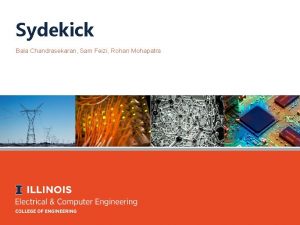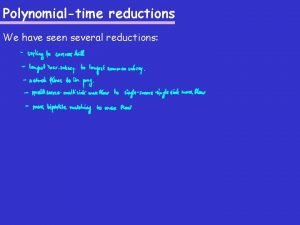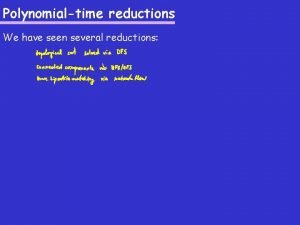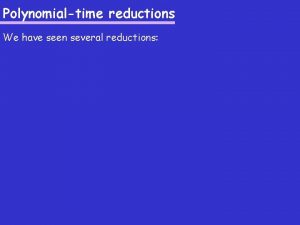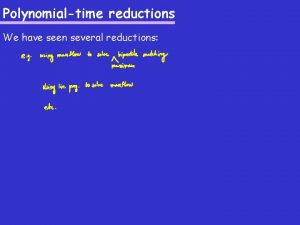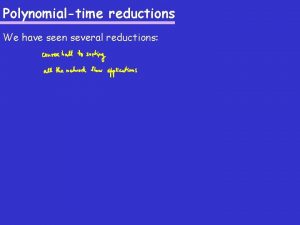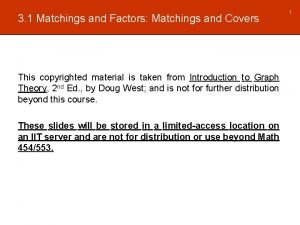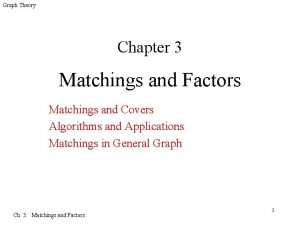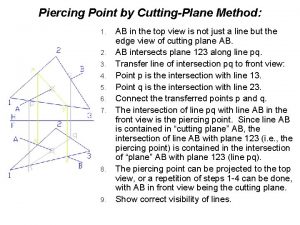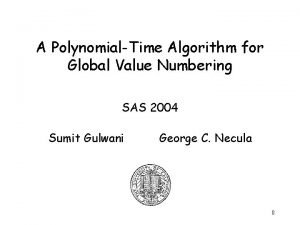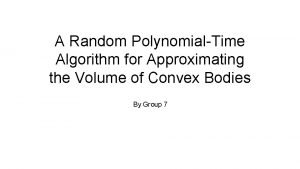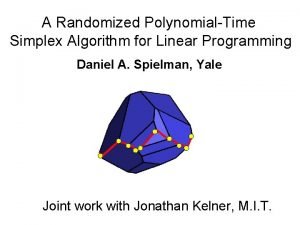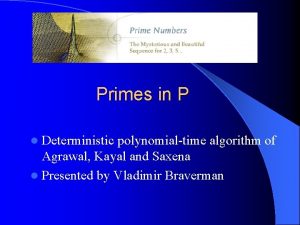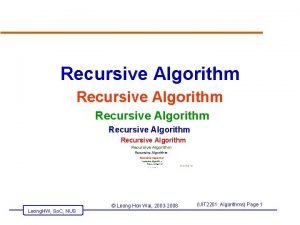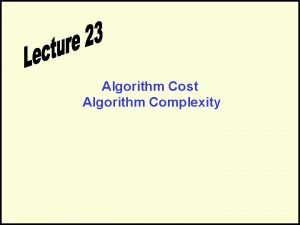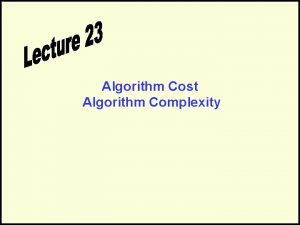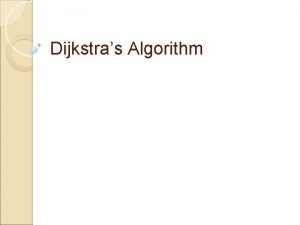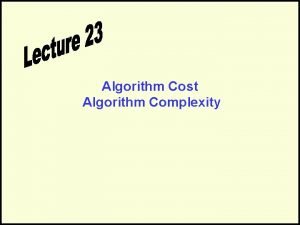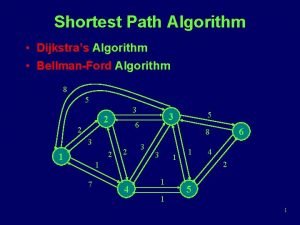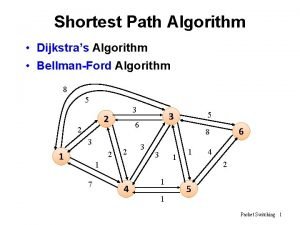A PolynomialTime CuttingPlane Algorithm for Matchings Karthekeyan Chandrasekaran



































- Slides: 35

A Polynomial-Time Cutting-Plane Algorithm for Matchings Karthekeyan Chandrasekaran Harvard University Joint work with L. Vegh and S. Vempala

Cutting Plane Method

Cutting Plane Method §

Cutting Plane Method §

Requirements – Efficient and Correct § § Is the cutting plane method efficient for polynomial -time solvable combinatorial problems? § Theoretical bound on the number of steps to convergence of cutting plane method for such problems? Question: Can we explain the efficiency in practical implementations?

Minimum-Cost Perfect Matching § Problem: Given an edge cost function in a graph, find a minimum cost perfect matching § IP formulation:

LP Relaxation (Bipartite Relaxation) Ø In bipartite graphs, the solution is the indicator vector of a perfect matching in the graph Ø In non-bipartite graphs, the solution is not necessarily integral • Solution is half-integral and supported by a disjoint union of edges and odd cycles


§ § Easy to find cuts in the first step Ø Starting LP optimum is half-integral and supported by a disjoint union of odd cycles and edges - need Padberg-Rao for cut § Half-integral structure is not preserved in later steps generation


Outline § Cutting Plane Method for Integer Programs § Perfect Matching and Linear Constraints § Results and Techniques Ø New Cutting Plane Algorithm for Matching Ø Analysis Overview • Half-integral Structure • Progress § Coupling with a new Combinatorial Primal-Dual Algorithm for Matching

New Cutting Plane Algorithm To ensure uniqueness of intermediate optima Final integral optimum to perturbed cost function is also optimum to original cost function

An Example

New Cutting Plane Algorithm

An Example

New Cutting Plane Algorithm

Analysis Overview §

Analysis Overview

Analysis Overview (i) Half-integral Structure: Intermediate LP optima are half-integral and supported by a disjoint union of odd cycles and edges

Half-integral Structure § Conjecture 0: All intermediate solutions are Half§ integral Conjecture 1: Half-integral if odd-set inequalities correspond to a laminar family Hey look – the optima are not unique!

Half-integral Structure § Conjecture 2: Half-integral if the optimum is unique and odd-set inequalities correspond to a laminar family

Half-integral Structure §

Half-integral Structure Tight Edge • Projection of primal-dual optimal pair gives primal-dual optimal pair in the contracted instance

Half-integral Structure • Projection of primal-dual optimal pair gives primal-dual optimal pair in the contracted instance

New Cutting Plane Algorithm

Analysis Overview (i) Half-integral Structure: Intermediate LP optima are half-integral and supported by a disjoint union of odd cycles and edges Proof of Cut Retention: Coupling with the intermediate solutions of a Half-Integral Primal-Dual Algorithm for matching Ø The choice of specific dual optimal solution to retain cuts comes from this coupling

Edmonds’ Algorithm (Bipartite)

Edmonds’ Algorithm (Nonbipartite) Blosso m §

Edmonds’ Algorithm (Nonbipartite) §

Half-Integral Primal-Dual Algorithm Edmonds’ Algorithm Half-Integral Algorithm � Intermediate Primal – integral � Intermediate Primal – half-integral � Unique way to augment primal � 3 ways to augment primal � Build an alternating tree using tight edges and repeatedly attempt to augment primal and change dual values until there are no more exposed nodes � Deshrink if dual value on a set decreases to zero � Shrink if a set forms a blossom � Deshrink if dual value on a set decreases to zero � Augment primal if a set forms a blossom

Half-Integral Primal-Dual Algorithm Primal Augmentations

Half-Integral Primal-Dual Algorithm Edmonds’ Algorithm Half-Integral Algorithm � Intermediate Primal – integral � Intermediate Primal – half-integral � Unique way to augment primal � 3 ways to augment primal � Build an alternating tree using tight edges and repeatedly attempt to augment primal and change dual values. Node until there are no more Covering Phase exposed nodes edges and repeatedly attempt to augment primal and change dual values until there are no more exposed nodes � Deshrink if dual value on a set decreases to zero � Shrink. Cycle if a set forms a blossom Shrinking Phase � Deshrink if dual value on a set decreases to zero � Augment primal if a set forms a blossom � After covering all exposed nodes, shrink all odd cycles to exposed

Half-Integral Primal-Dual Algorithm Primal Augmentations

Half-Integral Primal-Dual Algorithm §

Future Directions § Implications of the Dual-based cut-retention procedure for other poly-time solvable combinatorial problems Ø Combinatorial polytopes with Chvátal rank one (Edmonds-Johnson matrices) § Efficient cutting plane algorithms for optimization over Ø two-matroid-intersection polytope Ø subtour elimination polytope Questions? Thank you
 Bala chandrasekaran
Bala chandrasekaran Bala chandrasekaran
Bala chandrasekaran Sirish chandrasekaran
Sirish chandrasekaran Stål för stötfångarsystem
Stål för stötfångarsystem Personalliggare bygg undantag
Personalliggare bygg undantag Verktyg för automatisering av utbetalningar
Verktyg för automatisering av utbetalningar Vishnuiter
Vishnuiter Centrum för kunskap och säkerhet
Centrum för kunskap och säkerhet Omprov cellprov
Omprov cellprov Bo bergman jag fryser om dina händer
Bo bergman jag fryser om dina händer Inköpsprocessen steg för steg
Inköpsprocessen steg för steg Strategi för svensk viltförvaltning
Strategi för svensk viltförvaltning Informationskartläggning
Informationskartläggning Relativ standardavvikelse formel
Relativ standardavvikelse formel Datorkunskap för nybörjare
Datorkunskap för nybörjare Tack för att ni har lyssnat
Tack för att ni har lyssnat Klassificeringsstruktur för kommunala verksamheter
Klassificeringsstruktur för kommunala verksamheter Vad står k.r.å.k.a.n för
Vad står k.r.å.k.a.n för Läkarutlåtande för livränta
Läkarutlåtande för livränta Påbyggnader för flakfordon
Påbyggnader för flakfordon Tack för att ni lyssnade
Tack för att ni lyssnade Egg för emanuel
Egg för emanuel Atmosfr
Atmosfr Vilotidsbok
Vilotidsbok Rutin för avvikelsehantering
Rutin för avvikelsehantering Biologiska arvet
Biologiska arvet Verifikationsplan
Verifikationsplan Kontinuitetshantering
Kontinuitetshantering Myndigheten för delaktighet
Myndigheten för delaktighet Presentera för publik crossboss
Presentera för publik crossboss Kung dog 1611
Kung dog 1611 Debattartikel mall
Debattartikel mall Tobinskatten för och nackdelar
Tobinskatten för och nackdelar Tack för att ni har lyssnat
Tack för att ni har lyssnat Tack för att ni lyssnade bild
Tack för att ni lyssnade bild Hur ser ett referat ut
Hur ser ett referat ut

